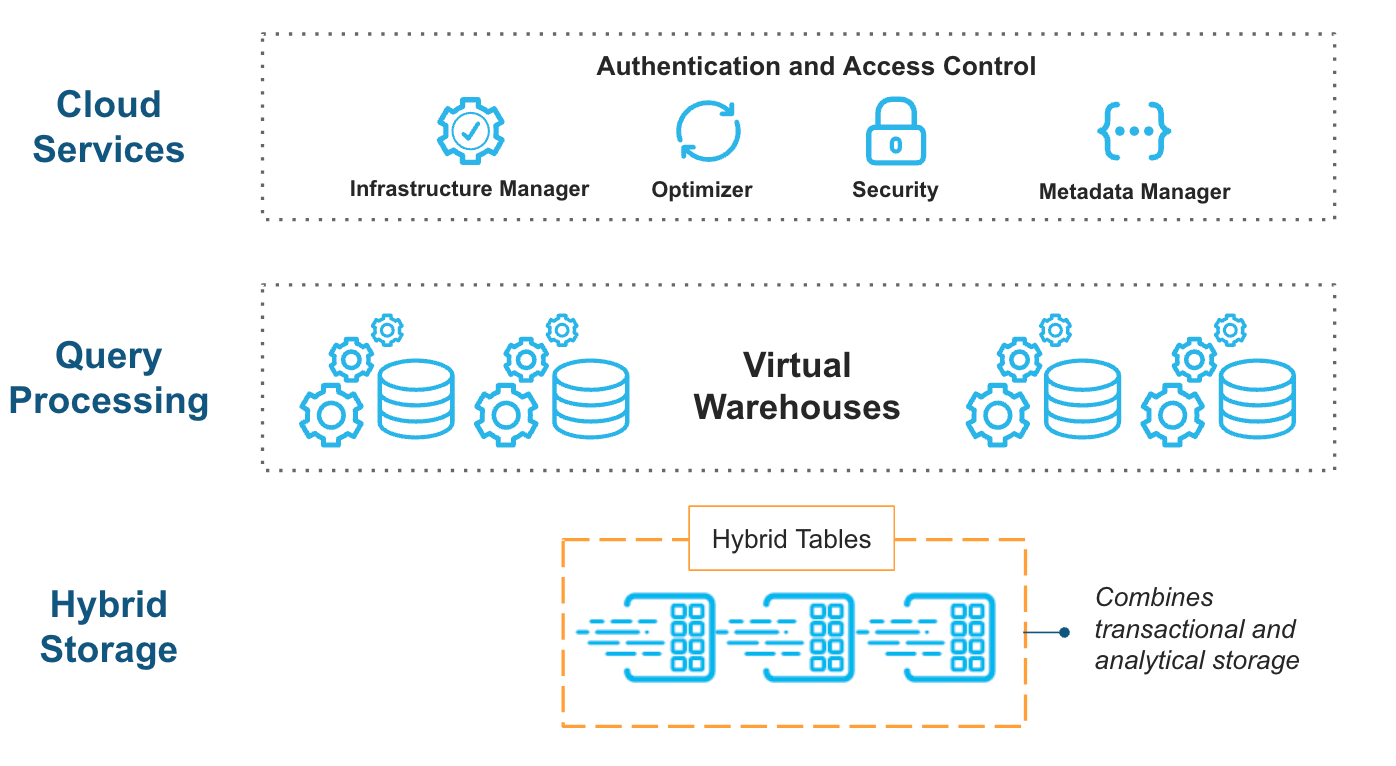
We previously announced Snowflake’s Unistore workload, which continues Snowflake’s legacy of breaking down data silos by uniting transactional and analytical data in a consistent and governed platform. Today, we are pleased to announce that Hybrid Tables — the core feature powering Unistore — is in public preview in select AWS regions.
Hybrid Tables is a new table type that enables transactional use cases within Snowflake with fast, high-concurrency point operations. Customers are simplifying their architectures by using Hybrid Tables for a variety of use cases, including storing app and workflow state, serving data and building lightweight transactional applications.
 Hybrid Tables combine transactional and analytical storage, leveraging the same cloud services and query processing layers as standard tables.
Hybrid Tables combine transactional and analytical storage, leveraging the same cloud services and query processing layers as standard tables.
Get started quickly with the syntax you know
Hybrid Tables are easy to use and simple to manage. They are powered by a completely new storage engine and integrated deeply into the existing Snowflake architecture. Hybrid Tables leverage the same cloud services and query processing layers as standard tables to provide a unified experience supporting the rich Snowflake features that you know and love.
To use Hybrid Tables, you simply connect to Snowflake, select a warehouse and create a new Snowflake table using the HYBRID keyword. Then you execute SQL against a Hybrid Table in the same way you would query any table in Snowflake:
CREATE HYBRID TABLE Customers ( Customerkey number(38,0) PRIMARY KEY, Customername varchar(50) UNIQUE );
Hybrid Tables provide several new capabilities that help customers build data-intensive applications on Snowflake:
- Fast point operations are enabled by a new row storage engine — which serves as the primary data store for Hybrid Tables — and deep optimizations for transactional workloads in the Cloud Services and Virtual Warehouse layers of the Snowflake architecture.
- Row locking facilitates high-concurrency random writes.
- Primary Key, Foreign Key and Unique Constraints enforce data integrity within your application.
- Indexes provide fast lookups for common access paths.
- Analytics and transactional workload isolation on the same data is provided through a separate read copy of your data in object storage, columnar caching and Snowflake’s separated elastic compute. You can power your analytical workflows directly on top of your transactional data in near real time without impacting your ongoing operational workload.
The most powerful aspect of Hybrid Tables is that it is just another table type in Snowflake’s unified platform. This greatly simplifies the experience of working with data for app developers, data engineers, architects and admins. Here are a few examples of what this deep integration provides:
- Unified data governance: Govern all of your transactional and analytical data with one central set of policies. Your security and access policies, including column masking and row-level security, work seamlessly with Hybrid Tables out of the box.
- Consistency: Execute atomic transactions encompassing Hybrid Tables and other Snowflake table types so that your data is never out of sync.
- Hybrid querying: Efficiently join data across Hybrid Tables and other Snowflake table types in the same query engine. No lag, no copying, no federation.
Hybrid Tables in action
Snowflake customers are taking advantage of Hybrid Tables to simplify their architectures and expand to new use cases. For example, in order to control which ads users see, William Hill stores precomputed promotion treatments in a Hybrid Table and serves that data with low latency to their web and mobile apps. “Serving promotion treatment from Hybrid Tables reduces point lookup latency and allowed us to maintain unified governance by keeping all of that sensitive data within Snowflake,” says Rahul Jha, Senior Data Architect at William Hill.
MarketWise Solutions, the services division of MarketWise, joined the Hybrid Tables private preview and was impressed by how much it simplified ingest and export ETL workflows. Hybrid Tables’ ability to handle large volumes of writes while allowing for analytical reporting enabled MarketWise to reduce the infrastructure overhead and data movement involved in ingest workflows. In a second use case with export ETL jobs, MarketWise Solutions found that Hybrid Tables gave them a robust solution to store, update and maintain audit logs about what data is leaving their system and where it’s going. Read more about MarketWise Solutions’ Hybrid Tables experience.
What’s next?
We’re incredibly excited to see how customers are using Hybrid Tables to simplify existing use cases and build new ones. Throughout the public preview period, we will continue to improve performance, throughput and scale to support a broader range of use cases and deliver key Snowflake feature integrations. But this is just the starting point for Hybrid Tables and Unistore—stay tuned as we expand to all Snowflake AWS regions and all cloud regions.
Start building
Check out the documentation to learn more about Hybrid Tables or try it for yourself with this Quickstart, then explore more resources and customer stories on the Unistore page. Note: Hybrid Tables is not available for free trial accounts.
Forward-Looking Statements
This blog contains express and implied forward-looking statements, including statements regarding Snowflake products, services and technology offerings that are under development. These forward-looking statements are subject to a number of risks, uncertainties and assumptions. In light of these risks, uncertainties and assumptions, actual results could differ materially and adversely from those anticipated or implied in the forward-looking statements. As a result, you should not rely on any forward-looking statements as predictions of future events.




